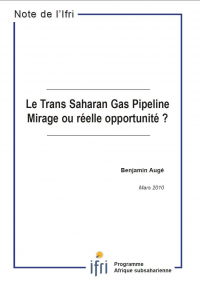Gateway to Think Tanks
| 来源类型 | Publications - Policy Papers |
| 规范类型 | 简报 |
| DOI | 978-2-86592-740-1 |
| The Trans-Saharan Gas Pipeline: An Illusion or a Real Prospect Notes de l'Ifri, March 2010 | |
| Benjamin AUGE | |
| 发表日期 | 2010-03-18 |
| 出版年 | 2010 |
| 概述 | 8 % of worldwide gas reserves are located on the African continent. Its relative economic weakness and the almost total absence of gas networks leads to a very reduced interior consumption (almost nonexistent outside Algeria and Egypt) which permits an important export capacity of the... |
| 摘要 |
The Trans-Saharan Gas Pipeline: An Illusion or a Real Prospect Notes de l'Ifri, March 2010
8 % of worldwide gas reserves are located on the African continent. Its relative economic weakness and the almost total absence of gas networks leads to a very reduced interior consumption (almost nonexistent outside Algeria and Egypt) which permits an important export capacity of the continent’s gas. Linking Sub-Saharan-Africa and the European Union (EU) with a gas pipeline thus is a reasonable project in economic terms.  The two sides are discussing the project with increasing intensity since the beginning of the 21st century. The strategy seems to be obvious. The European zone counts three important gas producing countries: Norway (not a member of the EU but closely associated to the Union’s energy policy), Great Britain and the Netherlands, with a respective production of 99.2, 69.5 and 67.5 billion cubic meters in 2008. However, the production of Norway and the Netherlands will start to decrease in a few years; that of Great Britain is already diminishing significantly since 2000 and the British currently import a third of their gas in order to satisfy their needs for domestic consumption (93.9 billion cubic meters in 2008). Mathematically, EU imports will progressively increase. Fearing a dependence on Russian gas (today 25 % on average among the 27) in the near future has led the EU to develop a policy of diversification in sources of supply. If no diversification is put in place, Russia might supply about 70% of the European market (27 countries) by 2050. The option to multiply the number of re-gasification plants to import Liquefied Natural Gas (LNG) is currently clearly privileged by various EU member states such as France, Italy, Spain, the United Kingdom, the Netherlands and Poland. Persian Gulf countries, Egypt, Algeria and the United States will supply these new plants. The Trans-Saharan Gas Pipeline (TSGP), which will link Nigeria, Niger and Algeria, itself already connected to Spain and Italy by existing or under construction pipelines, could emerge as an additional source of supply in the long term. However, while this 4 128 km-long pipeline considered as a priority by the NEPAD is not a dream and not even a challenge in technical terms, solutions for several financial, security and geopolitical issues have to be found before a hypothetical formal decision can be made to further develop the project in the coming years. Benjamin Augé is a Phd student at the French Geopolitics Institute, University of Paris 8.
The Trans-Saharan Gas Pipeline: An Illusion or a Real Prospect
|
| 关键词 | gas gas pipeline Liquefied Natural Gas LNG Afrique subsaharienne Europe European Union Sahara |
| URL | https://www.ifri.org/en/publications/enotes/notes-de-lifri/trans-saharan-gas-pipeline-mirage-or-real-opportunity |
| 来源智库 | French Institute of International Relations (France) |
| 引用统计 | |
| 资源类型 | 智库出版物 |
| 条目标识符 | http://119.78.100.153/handle/2XGU8XDN/415367 |
| 推荐引用方式 GB/T 7714 | Benjamin AUGE. The Trans-Saharan Gas Pipeline: An Illusion or a Real Prospect Notes de l'Ifri, March 2010. 2010. |
| 条目包含的文件 | ||||||
| 文件名称/大小 | 资源类型 | 版本类型 | 开放类型 | 使用许可 | ||
| couverturenoteauge.j(27KB) | 智库出版物 | 限制开放 | CC BY-NC-SA |  浏览 | ||
| auge_the_trans_sahar(598KB) | 智库出版物 | 限制开放 | CC BY-NC-SA | 浏览 | ||
除非特别说明,本系统中所有内容都受版权保护,并保留所有权利。